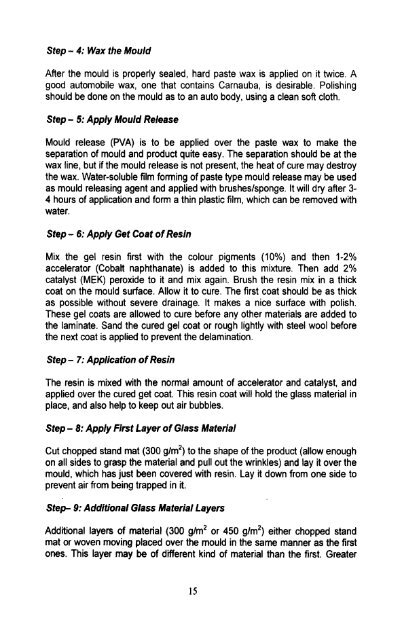Director Ambekar E. Eknath, Ph. D Head, APED J.K. Jena, Ph. D ...
Director Ambekar E. Eknath, Ph. D Head, APED J.K. Jena, Ph. D ...
Director Ambekar E. Eknath, Ph. D Head, APED J.K. Jena, Ph. D ...
Create successful ePaper yourself
Turn your PDF publications into a flip-book with our unique Google optimized e-Paper software.
Step - 4: Wax the Mould<br />
After the mould is properly sealed, hard paste wax is appl~ed on it hvice. A<br />
good automobile wax, one that contains Carnauba, IS desirable. Polishing<br />
should be done on the mould as to an auto body, using a clean soft cloth.<br />
Step - 5: Apply Mould Release<br />
Mould release (PVA) is to be applied over the paste wax to make the<br />
separation of mould and product quite easy. The separation should be at the<br />
wax line, but if the mould release is not present, the heat of cure may destroy<br />
the wax. Water-soluble film forming of paste type mould release may be used<br />
as mould releasing agent and applied with brusheslsponge. It will dry after 3-<br />
4 hours of application and form a thin plastic film, which can be removed with<br />
water.<br />
Step - 6: Apply Get Coat of Resin<br />
Mix the gel resin first with the colour pigments (10%) and then 1-2%<br />
accelerator (Cobalt naphthanate) is added to this mixture. Then add 2%<br />
catalyst (MEK) peroxide to it and mix again. Brush the resin mix in a thick<br />
coat on the mould surface. Allow it to cure. The first coat should be as thick<br />
as possible without severe drainage. It makes a nice surface with polish.<br />
These gel coats are allowed to cure before any other materials are added to<br />
the laminate. Sand the cured gel coat or rough lightly with steel wool before<br />
the next coat is applied to prevent the delamination.<br />
Step - 7: Appllcation of Resin<br />
The resin is mixed with the normal amount of accelerator and catalyst, and<br />
applied over the cured get coat. This resin coat will hold the glass material in<br />
place, and also help to keep out air bubbles.<br />
Step - 8: Apply First Layer of Glass Material<br />
Cut chopped stand mat (300 g/m2) to the shape of the product (allow enough<br />
on all sides to grasp the material and pull out the wrinkles) and lay it over the<br />
mould, which has just been covered with resin. Lay it down from one side to<br />
prevent air from being trapped in it.<br />
Step- 9: Additional Glass Material Layers<br />
Additional layers of material (300 glmZ or 450 glm2) either chopped stand<br />
mat or woven moving placed over the mould in the same manner as the first<br />
ones. This layer may be of different kind of material than the first. Greater

















